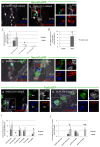Aldh1-expressing endocrine progenitor cells regulate secondary islet formation in larval zebrafish pancreas
- PMID: 24147152
- PMCID: PMC3798260
- DOI: 10.1371/journal.pone.0074350
Aldh1-expressing endocrine progenitor cells regulate secondary islet formation in larval zebrafish pancreas
Abstract
Aldh1 expression is known to mark candidate progenitor populations in adult and embryonic mouse pancreas, and Aldh1 enzymatic activity has been identified as a potent regulator of pancreatic endocrine differentiation in zebrafish. However, the location and identity of Aldh1-expressing cells in zebrafish pancreas remain unknown. In this study we demonstrate that Aldh1-expressing cells are located immediately adjacent to 2F11-positive pancreatic ductal epithelial cells, and that their abundance dramatically increases during zebrafish secondary islet formation. These cells also express neurod, a marker of endocrine progenitor cells, but do not express markers of more mature endocrine cells such as pax6b or insulin. Using formal cre/lox-based lineage tracing, we further show that Aldh1-expressing pancreatic epithelial cells are the direct progeny of pancreatic notch-responsive progenitor cells, identifying them as a critical intermediate between multi-lineage progenitors and mature endocrine cells. Pharmacologic manipulation of Aldh1 enzymatic activity accelerates cell entry into the Aldh1-expressing endocrine progenitor pool, and also leads to the premature maturation of these cells, as evidenced by accelerated pax6b expression. Together, these findings suggest that Aldh1-expressing cells act as both participants and regulators of endocrine differentiation during zebrafish secondary islet formation.
Conflict of interest statement
Figures







Similar articles
-
Aldehyde dehydrogenase 1 activity in the developing human pancreas modulates retinoic acid signalling in mediating islet differentiation and survival.Diabetologia. 2014 Apr;57(4):754-64. doi: 10.1007/s00125-013-3147-y. Epub 2013 Dec 28. Diabetologia. 2014. PMID: 24374552
-
Multipotential nestin-positive stem cells isolated from adult pancreatic islets differentiate ex vivo into pancreatic endocrine, exocrine, and hepatic phenotypes.Diabetes. 2001 Mar;50(3):521-33. doi: 10.2337/diabetes.50.3.521. Diabetes. 2001. PMID: 11246871
-
Retinoic acid plays an evolutionarily conserved and biphasic role in pancreas development.Dev Biol. 2014 Oct 1;394(1):83-93. doi: 10.1016/j.ydbio.2014.07.021. Epub 2014 Aug 13. Dev Biol. 2014. PMID: 25127993 Free PMC article.
-
Direct lineage tracing reveals the ontogeny of pancreatic cell fates during mouse embryogenesis.Mech Dev. 2003 Jan;120(1):35-43. doi: 10.1016/s0925-4773(02)00330-1. Mech Dev. 2003. PMID: 12490294 Review.
-
Lineage commitment and cellular differentiation in exocrine pancreas.Pancreatology. 2001;1(6):587-96. doi: 10.1159/000055868. Pancreatology. 2001. PMID: 12120241 Review.
Cited by
-
The Ribosome Biogenesis Protein Nol9 Is Essential for Definitive Hematopoiesis and Pancreas Morphogenesis in Zebrafish.PLoS Genet. 2015 Dec 1;11(12):e1005677. doi: 10.1371/journal.pgen.1005677. eCollection 2015 Dec. PLoS Genet. 2015. PMID: 26624285 Free PMC article.
-
Differential levels of Neurod establish zebrafish endocrine pancreas cell fates.Dev Biol. 2015 Jun 1;402(1):81-97. doi: 10.1016/j.ydbio.2015.03.007. Epub 2015 Mar 20. Dev Biol. 2015. PMID: 25797153 Free PMC article.
-
Vegfa/vegfr2 signaling is necessary for zebrafish islet vessel development, but is dispensable for beta-cell and alpha-cell formation.Sci Rep. 2019 Mar 5;9(1):3594. doi: 10.1038/s41598-019-40136-1. Sci Rep. 2019. PMID: 30837605 Free PMC article.
-
Sox9b is a mediator of retinoic acid signaling restricting endocrine progenitor differentiation.Dev Biol. 2016 Oct 1;418(1):28-39. doi: 10.1016/j.ydbio.2016.08.019. Epub 2016 Aug 24. Dev Biol. 2016. PMID: 27565026 Free PMC article.
-
Fate mapping of ptf1a-expressing cells during pancreatic organogenesis and regeneration in zebrafish.Dev Dyn. 2015 Jun;244(6):724-35. doi: 10.1002/dvdy.24271. Epub 2015 May 22. Dev Dyn. 2015. PMID: 25773748 Free PMC article.
References
Publication types
MeSH terms
Substances
Grants and funding
LinkOut - more resources
Full Text Sources
Other Literature Sources
Medical
Molecular Biology Databases
Miscellaneous

